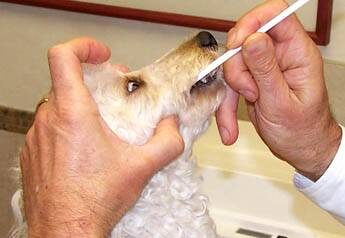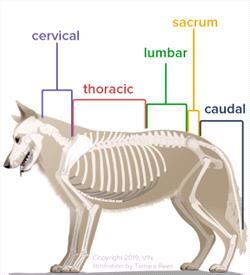Toothbrushing and Dental Prophylaxis in Cats and Dogs
Why Should I Brush My Dog’s Or Cat’s Teeth?
Daily removal of plaque is the key to an oral hygiene program. Unless your pet’s teeth are brushed daily, plaque, which is an accumulation of bacteria, will build up at the gum line. Eventually calculus forms, further irritating the gums, and then infection progresses to loosen and destroy the tooth’s attachment. In addition to loose teeth, infection under the gumline can spread to the liver, kidneys, and he

How Can I Brush My Animal’s Teeth?
It is usually an easy and fun procedure. First pick a soft-bristled or finger toothbrush. Next, get toothpaste from your veterinarian. Do not use human toothpaste because it has detergents that should not be swallowed.
How About Wipes?
Dental wipes can be effective in removing plaque. Be sure to wipe the area where the tooth meets the gum line.
What Is The VOHC?
The Veterinary Oral Health Council (VOHC) is a non-profit organization composed of board certified veterinary dentists that reviews studies and accepts dental products that have been shown to reduce the accumulation of plaque and/or tartar. They list their approved products,and the products have a VOHC seal of approval on the packaging.

How Often Does My Pet Need To Have Teeth Cleaned By The Veterinarian?
It depends on the degree of plaque and tartar accumulation. You need to examine your pet’s teeth monthly. Look for an accumulation of yellow or brown material at the area where the tooth meets the gumline especially over the cheek teeth and canines.
Once you notice plaque or tartar accumulation, it is time for a professional cleaning. Do not wait.
Attached to the tartar are bacteria, which irritate gum tissues. When treated, the inflammation will resolve. When gingivitis is left untreated, it will progress to periodontitis, which is non-curable.
The intervals between teeth cleaning procedures will depend on how often you can brush your pet’s teeth. Once or twice daily cleaning is optimum. If you cannot brush the teeth, then your pet will probably need two or three teeth cleaning visits yearly.
Can I Just Take My Fingernail Or A Dental Scaler To Remove The Calculus?
Dental disease occurs below the gum line. By removing calculus from the tooth, you are not removing disease below the gum line. In order to thoroughly help your pet, plaque and calculus must be removed from below the gum line.
Do You Have To Use Anesthesia To Clean My Pet’s Teeth?
Anesthesia is necessary when performing teeth cleaning. Anesthesia provides three important functions: immobilization in order to clean below the gum line, pain control, and the ability to place a tube into the windpipe, so bacterial products do not enter the respiratory system.
I Am Concerned About The Anesthesia. Is It Safe?
We take every effort to provide safe anesthesia. We use gas anesthetic agents; dogs and cats are given pre-operative tests depending on their age and condition to qualify them for anesthesia; and patients are monitored while anesthetized both visibly and with similar monitoring devices as used in human hospitals.
What Is Involved In The Teeth Cleaning At Your Hospital?
Each Oral Assessment, Treatment, and Prevention (Oral ATP) visit has twelve separate steps:
- general exam before anesthesia, pre-operative organ testing
- oral exam under anesthesia
- gross calculus removal
- subgingival (below the gumline) scaling, root planing, curettage where indicated
- tooth polishing
- irrigation
- fluoride / OraVet application
- post cleaning exam and dental x-rays to evaluate the areas below the gum line
- dental charting to create a treatment plan
- therapy if necessary
- home care instructions
- no-fee follow up appointment to see how well you are performing home care.
How Much Does A Tooth Cleaning Procedure Cost?
It is impossible to determine what the procedure will cost because we do not know the status of your pet’s teeth and gums. There are four levels of teeth cleanings at our hospital. Fees are based on severity plus costs for preoperative testing, anesthesia, necessary therapy, and medication. Fees for all dental services are available by e-mail or fax. The doctor or staff will provide an initial treatment plan based on exam room findings and a follow up treatment plan with fees after a tooth-by-tooth exam is conducted under anesthesia.
What Is The Best Food For My Pet?
Hard food will help remove plaque from teeth. There are special diets specifically manufactured to help control plaque. Feeding the special diets in conjunction with daily brushing is the best to keep the teeth clean. Diet alone will not control plaque, but it will help.
What Toys Should I Avoid To Protect My Pet’s Teeth?
Chewing on objects harder than teeth may lead to dental fractures. Be especially careful with cow and horse hoofs. They commonly cause fractures of the upper fourth premolars. Tug-of-war games must not be practiced, especially in young dogs and cats in order to avoid moving growing teeth to abnormal locations. Throwing dogs discs can also cause trauma to the teeth, resulting in pulpitis (an inflammation of the pulp).
What Are Cat Cavities?
Many cats get painful lesions at the gum line that invade teeth. They are properly referred to as tooth resorptions. Unfortunately we do not know what causes tooth resorption, and the most effective treatment involves extraction of the affected tooth. Check to see if your cat has an advanced resorption by pressing a cotton-tipped applicator to the gum line. If a painful lesion is noted, your cat will chatter its jaw.
How Can I Tell If My Pet Is Suffering From Periodontal Disease?
The leading sign is bad breath. Dogs and cats should not have disagreeable mouth odor. Bad breath comes from infection. If your pet’s breath does not smell like roses, let us examine its mouth and advise care.
What Type Of Tests Are Done To Diagnose Dental Disease?
If your pet has periodontal disease or a fractured tooth, an oral exam is performed while under anesthesia. A periodontal probe is used to evaluate bone loss around each tooth. X-rays are taken to evaluate if the teeth can be saved or need to be extracted.
When Do I Have To Start Worrying About Dental Problems With My Pet?
As soon as puppy or kitten teeth emerge, it’s time to start brushing. Although baby teeth are replaced with adult teeth, the puppy or kitten gets used to the brushing procedure, which continues for life.
What Can Be Done If My Pet Has Periodontal Disease?
Periodontal disease occurs when tooth support structures are affected by infection. In the beginning stages, cleaning above and below the gum line as well as removal of calculus attached to the tooth will help restore periodontal health. In advanced cases, either periodontal surgery or extractions are performed. Antibiotics given monthly also help to control the progression of periodontal disease.
Which Animals Are At Most Risk For Periodontal Disease?
Smaller breeds are more prone than larger because the teeth are closer together in small dogs, and they usually live longer. Terriers, Maltese, and Shih Tzus are especially prone to periodontal disease.
What Can You Do To Fix A Broken Tooth?
If your dog or cat breaks a tooth, there are two treatments: root canal therapy or extraction. You cannot leave the tooth alone with an exposed nerve. In addition to pain, infection will soon develop that can spread to the rest of your pet’s body.















